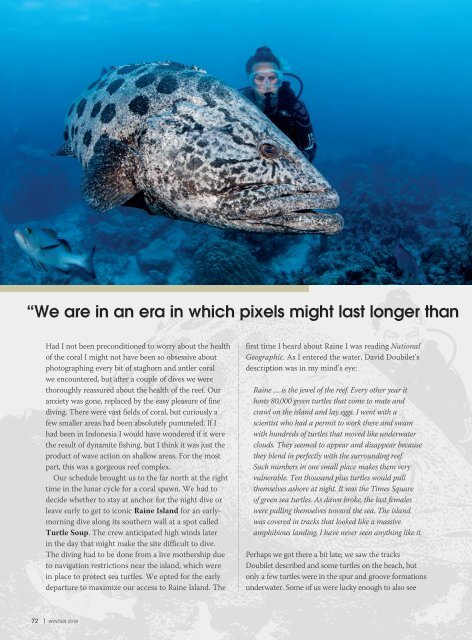AD 2018 Q1
Alert Diver is the dive industry’s leading publication. Featuring DAN’s core content of dive safety, research, education and medical information, each issue is a must-read reference, archived and shared by passionate scuba enthusiasts. In addition, Alert Diver showcases fascinating dive destinations and marine environmental topics through images from the world’s greatest underwater photographers and stories from the most experienced and eloquent dive journalists in the business.
Alert Diver is the dive industry’s leading publication. Featuring DAN’s core content of dive safety, research, education and medical information, each issue is a must-read reference, archived and shared by passionate scuba enthusiasts. In addition, Alert Diver showcases fascinating dive destinations and marine environmental topics through images from the world’s greatest underwater photographers and stories from the most experienced and eloquent dive journalists in the business.
Create successful ePaper yourself
Turn your PDF publications into a flip-book with our unique Google optimized e-Paper software.
“We are in an era in which pixels might last longer than<br />
Had I not been preconditioned to worry about the health<br />
of the coral I might not have been so obsessive about<br />
photographing every bit of staghorn and antler coral<br />
we encountered, but after a couple of dives we were<br />
thoroughly reassured about the health of the reef. Our<br />
anxiety was gone, replaced by the easy pleasure of fine<br />
diving. There were vast fields of coral, but curiously a<br />
few smaller areas had been absolutely pummeled. If I<br />
had been in Indonesia I would have wondered if it were<br />
the result of dynamite fishing, but I think it was just the<br />
product of wave action on shallow areas. For the most<br />
part, this was a gorgeous reef complex.<br />
Our schedule brought us to the far north at the right<br />
time in the lunar cycle for a coral spawn. We had to<br />
decide whether to stay at anchor for the night dive or<br />
leave early to get to iconic Raine Island for an earlymorning<br />
dive along its southern wall at a spot called<br />
Turtle Soup. The crew anticipated high winds later<br />
in the day that might make the site difficult to dive.<br />
The diving had to be done from a live mothership due<br />
to navigation restrictions near the island, which were<br />
in place to protect sea turtles. We opted for the early<br />
departure to maximize our access to Raine Island. The<br />
first time I heard about Raine I was reading National<br />
Geographic. As I entered the water, David Doubilet’s<br />
description was in my mind’s eye:<br />
Raine … is the jewel of the reef. Every other year it<br />
hosts 80,000 green turtles that come to mate and<br />
crawl on the island and lay eggs. I went with a<br />
scientist who had a permit to work there and swam<br />
with hundreds of turtles that moved like underwater<br />
clouds. They seemed to appear and disappear because<br />
they blend in perfectly with the surrounding reef.<br />
Such numbers in one small place makes them very<br />
vulnerable. Ten thousand plus turtles would pull<br />
themselves ashore at night. It was the Times Square<br />
of green sea turtles. As dawn broke, the last females<br />
were pulling themselves toward the sea. The island<br />
was covered in tracks that looked like a massive<br />
amphibious landing. I have never seen anything like it.<br />
Perhaps we got there a bit late; we saw the tracks<br />
Doubilet described and some turtles on the beach, but<br />
only a few turtles were in the spur and groove formations<br />
underwater. Some of us were lucky enough to also see<br />
72 | WINTER <strong>2018</strong>









